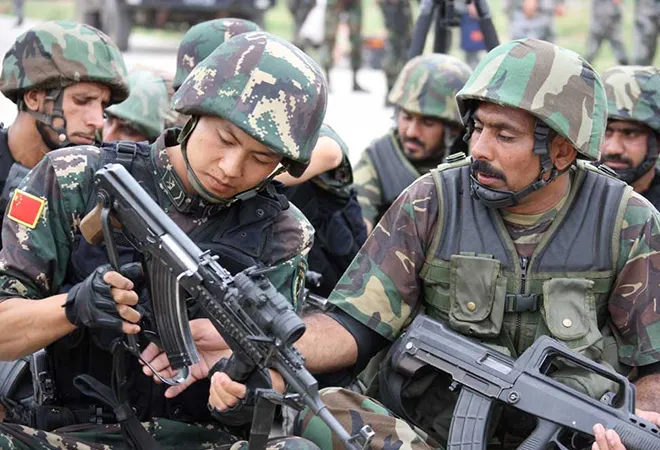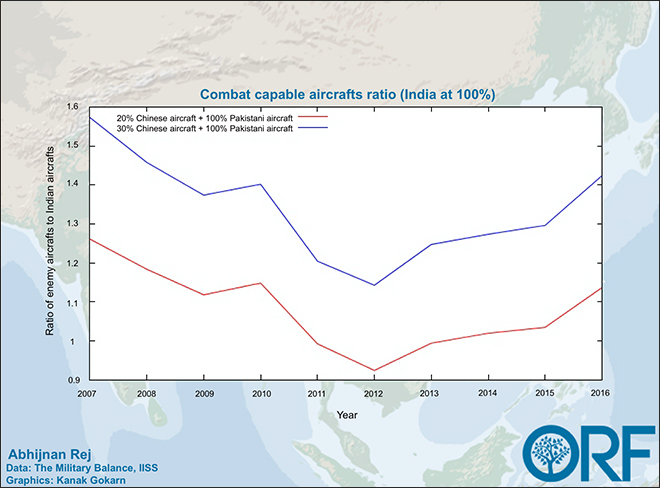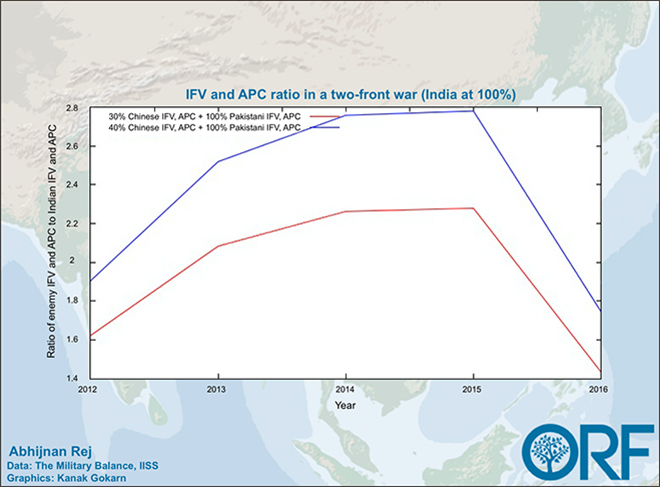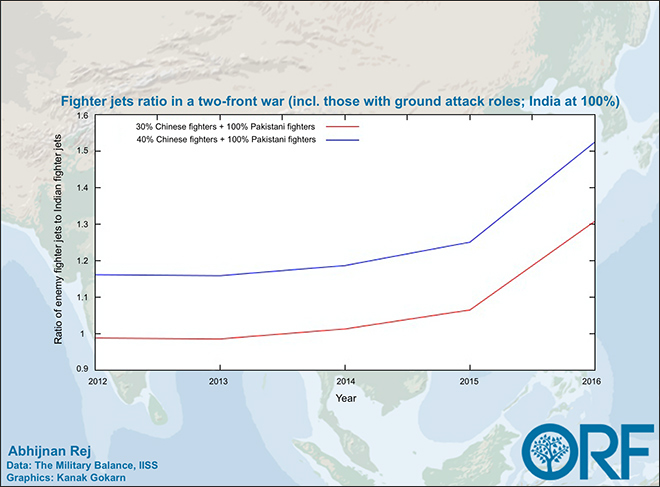 This is the fiftieth part in the series
This is the fiftieth part in the series The China Chronicles.
Read all the articles here.
As relations with both China and Pakistan continue to deteriorate, Indian policy-makers now find themselves contemplating the unpleasant possibility of a 'two-front' war with both countries. Whether such a war would be overtly collusive or not between China and Pakistan – that is, whether they would pre-plan a joint attack on India or it would be a case of strategic opportunism – it is clear to many in positions of authority that the Indian military remains fundamentally unprepared for such a challenge. But it can also be argued that a two-front force ratio (ratio of Pakistani and fraction of Chinese inventories to India’s) has evolved and varied considerably over time, as China continues to rapidly modernize as well as numerically increase its military (through significant increases in defence spending) and Indian military preparedness flounders.
In this article, such an evolution and variation of a two-front force ratio is quantitatively examined using time-series data constructed from ten IISS Military Balance volumes, from 2008 to 2017. (A convention: given that the volumes publish data from the year before, the data reported below will correspond to the volume from the following year. For example, data quoted here for, say, 2010 would be from the 2011 volume, and so on.) The key finding of the article is that this force ratio – never in India's favour to begin with – is currently rapidly shifting in favour of the adversary, even after considering smaller fractions of the Chinese military involved in a two-front conflict.
Before presenting the results, a caveat is in order. The article works with only seven equipment variables and a simple bean count. Therefore, a much more granular study is necessary for a firm establishment of the results. Having said that, the results that do appear are disturbing and portend ill for a future collusive threat from Pakistan and China. It also points to an urgent need to make qualitative and quantitative improvements in the Indian military.
Background
A two-front war could start against India in three different ways. Firstly, Pakistan takes advantage of an India-China conflict. Secondly, China engages in strategic opportunism in an India-Pakistan conventional military engagement. Finally, China and Pakistan together collude to launch a surprise-coordinated attack from both India’s east and west. Out of this, the first is the most probable given that China would be hesitant to be seen as being either opportunistic or overtly aggressive at a time when Beijing engages in a hard sell of its global aspirations throughout Asia. This also seems the case because of the simple fact that if China was to take on India directly, it could very well do so without Pakistani assistance. The likely possibility is a border war between India and China which Pakistan exploits to open a front across Kashmir in order for it to compensate for its inferior force ratio vis-à-vis India.
To see this, consider Figures 1 and 2 which plot the ratios of Pakistani and Chinese main battle tanks (MBT) and ratios of the two countries’ all combat capable aircrafts to India’s, respectively.
Figure 1

Figure 2

In terms of the ratio of Pakistani MBT to India’s, India has steadily lost its advantage. In 2007, this ratio stood at 0.61, which by 2016 had risen to 0.85. (The simplest way to read force ratio numbers is to see them as the adversary’s strength given one unit of Indian equipment. Therefore increasing force ratios signify depleting Indian strength.) The same pattern reappears when it comes to China, where the MBT ratio has risen from 1.89 in 2007 to 2.23 in 2016. For the total number of combat capable aircrafts the situation is marginally better (in a story of almost entirely bad news). In 2007, this ratio for Pakistan was 0.64, which ten years later decreased to 0.56. The total aircraft ratio between China and India has also decreased in the same period, from 3.12 to 2.87. Nevertheless, the Chinese superiority in these two metrics is striking.
It should also be noted that this analysis is not just a matter of bean-counting two variables. In a recent book, defence analysts Pravin Sawhney and Ghazala Wahab detail several ways in which the PLA enjoys a distinct advantage over India, such as leveraging integrated theatre commands as well as a unified rocket force that replaces antiquated artillery-based tactics. Furthermore, American political scientist Walter Ladwig III’s research has detailed qualitative variables – such as geography and posture – that show that India’s much-vaunted strategic superiority over Pakistan is a hollow claim.
Analysis of two-front force ratios
In order to model two-front force ratios (TFFR), the following formula has been used:
TFFR = (XPak + α×XChn)/XInd
Here XPak, XChn, and XInd denote total Pakistani, Chinese, and Indian equipment of a certain type X respectively, which could vary. In other words, X could be MBT or fighter aircrafts or some other equipment. The coefficient α is a number between 0 and 1 and specifies the fraction of Chinese equipment to be used by that country against India in a two-front war. In this article, α = 0.2, 0.3, or 0.4, meaning that it considers cases where China uses 20 percent, 30 percent or 40 percent of its equipment of a certain type against India. (Following conventions on how force ratios are calculated, it is assumed that India and Pakistan will deploy all of its equipment of a certain type in a conflict between them.)
The time series for the main battle tank TFFR is given in Figure 3.
Figure 3

Two things stand out about this graph: one, how the TFFR has dramatically changed since 2010, and two, how Pakistan stands to gain vis-à-vis its MBT force ratio in event of an India-China conflict (compare Figure 1 with 3). In order to understand the first point about Figure 3 better, it is instructive to look at the raw numbers behind it, in Table 1.
| YEAR |
INDIA |
PAKISTAN |
CHINA |
| 2007 |
4059 |
2461 |
7660 |
| 2008 |
4065 |
2461 |
7660 |
| 2009 |
4047 |
2461 |
6550 |
| 2010 |
4117 |
2386 |
7050 |
| 2011 |
3233 |
2411 |
7400 |
| 2012 |
3274 |
2411 |
7430 |
| 2013 |
2874 |
2501 |
6840 |
| 2014 |
2874 |
2531 |
6540 |
| 2015 |
2974 |
2561 |
6540 |
| 2016 |
3024 |
2561 |
6740 |
Table 1: India, Pakistan, and China MBT strength
While Pakistan’s MBT strength has remained near constant (with about a hundred MBT added over ten years), India’s MBT strength has significantly declined, by more than a thousand MBT. American scholar Shane Mason has recently argued this to be a reflection of Indian army’s “flat lined” capital budget, a result of the burden of creation of new mountain divisions to counter the Chinese threat. In order to rectify this problem, the Indian government is currently proposing to replace the antiquated T-72 MBT with FRCV (future ready combat vehicles), though this is far from fruition at the present. The decrease in the number of Chinese MBT can be explained by a general reorientation of the PLA under Xi Jinping away from a being a ground-centric force and towards greater naval and air capabilities for the Peoples Liberation Army Navy (PLAN), Peoples Liberation Army Air Force (PLAAF), and the Peoples Liberation Army Rocket Forces (PLARF).
It is the second point about Figure 3 that is more striking. Assume, as one of the plots in that figure does, that China deploys 30 percent of its MBT (α = 0.3, in the formula above) in a conflict with India. India’s overall MBT TFFR has depleted from 1.09 in 2010 to 1.52 in 2016 – a 39.4 percent decrease of the force ratio in this scenario. Therefore, Pakistan may indeed find it convenient to launch a limited attack in Kashmir in the event of an India-China war and forestall a counteroffensive by India along its western borders by leveraging the changed MBT ratio. This is in sharp distinction to the somewhat favourable Pakistan-India MBT ratio depicted in Figure 1 which would have prevented Pakistani adventurism to begin with, had China not been a factor.
The second TFFR is that of artillery strength, and the corresponding time series is depicted in Figure 4.
Figure 4

Again, the same story as with the MBT is true here. Even at 20 percent Chinese deployment, the artillery TFFR increased from 0.69 in 2007 to 0.73 ten years later. What could be perceived as a silver lining – that this is the only TFFR that is less than one for India – is not really so. During this period, the Indian artillery declined to 1618, but it is the dramatic reduction in Chinese artillery making the TFFR what it is. (Pakistan’s artillery strength has shown very modest growth in this period: 4291 in 2007 to 4472 in 2016.) Between 2007 and 2016, PLA reduced its artillery pieces by 4482. This reduction is reflected in recommissioning of the PLA Second Artillery Corps as the PLARF in December 2015. It suggests a move away from artillery pieces and into short- and medium-range precision-strike missiles in order to have the same tactical effect. In India, no such move is anticipated at the present.
The TFFR for total number of combat capable aircrafts are given in Figure 5.
Figure 5

In order to unpack the TFFR, it is important to look at the raw numbers behind them (Table 2).
| YEAR |
INDIA |
PAKISTAN |
CHINA |
| 2007 |
565 |
360 |
1762 |
| 2008 |
603 |
383 |
1653 |
| 2009 |
632 |
383 |
1617 |
| 2010 |
665 |
426 |
1687 |
| 2011 |
798 |
453 |
1693 |
| 2012 |
870 |
423 |
1903 |
| 2013 |
866 |
422 |
2193 |
| 2014 |
881 |
450 |
2239 |
| 2015 |
881 |
450 |
2306 |
| 2016 |
803 |
451 |
2307 |
Table 2: India, Pakistan, and China combat capable aircrafts
However, it is the serious depletion of the Indian Air Force’ strength – from 870 to 803 combat capable aircrafts, between 2012 and 2016 – along with a more than 21 percent increase in the number of such PLAAF aircrafts in that period that explains the plot. Just as in the case of the MBT TFFR, it is instructive to compare Figure 5 with Figure 2 in order to note the tremendous force multiplier the PLA is for the Pakistan military. In 2016, the Pakistan/India ratio went up from 0.56 to a TFFR of 1.14 in event of a two-front conflict, assuming a 20 percent Chinese involvement.
The variables considered so far may be – to some eyes – too crude to tell a fuller story. In order to examine this claim, consider two finer variables: the total number of armoured combat vehicles which can transport an infantry squad (sum of armoured personnel carriers and infantry fighting vehicles), and the total number of fighter planes (including those with a ground attack role). To start with, consider the TTFR of armoured combat transport vehicles in Figure 6.
Figure 6

In 2012, at 30 percent Chinese involvement, the TFFR for IFV and APC stood at 1.62. This decreased to 1.43 in 2016. Part of the reason behind this welcome development was the rapid ongoing mechanisation of the Indian infantry that has led to a massive induction of IFV between 2015 and 2016, from 1455 to 2500. (The Indian Army no longer uses the APC at its disposal; Pakistan, on the other hand, has only APCs.) The Chinese and Pakistani numbers of armoured combat transport vehicles remained relatively stable in this period.
The second finer-grained metric – of the number of fighter aircrafts, possibly with ground attack roles – is examined in the time series of Figure 7.
Figure 7

This is perhaps the most depressing plot of the lot. In 2012, India’s FGA and FTR strength together stood at 799 aircrafts. By 2016, this had depleted to 613 while the Chinese numbers in the same category remained stable. There is extensive commentary about the poor shape of the Indian air force, caught, as it is, in various bureaucratic turf wars and public controversy around acquisitions. Whatever be the reason, if the IAF depletes at the rate at which it is, fighting a two-front war will soon become a theoretical impossibility. Air Marshal BS Dhanoa noted last year, “Our numbers are not adequate to fully execute an air campaign in a two-front scenario. The probability of a two-front scenario is an appreciation which you need to do. But, are the numbers adequate? No.” The current analysis confirms his claim.
Notwithstanding the drawbacks that come with a bean-count, the analysis presented in this paper disabuses the claim that the Indian military is ready to fight a two-front, chest-thumping from some politically-motivated actors aside. It has become a trite observation by now that India, with its threat environment of two potentially collusive nuclear revisionists, ought to be spending more than 1.62 percent of its GDP on the military. What is more worrying is India’s loud proclamations about having arrived as a global power when – as it became clear through the preceding analysis – it has hardly been matched by increases in its hard power. Deng Xiaoping once exhorted his nation: “Hide your strength, bide your time.” India’s strength continues to hollow while biding time has become an exercise in futility.
The views expressed above belong to the author(s). ORF research and analyses now available on Telegram! Click here to access our curated content — blogs, longforms and interviews.



 This is the fiftieth part in the series The China Chronicles.
Read all the articles
This is the fiftieth part in the series The China Chronicles.
Read all the articles 






 PREV
PREV


